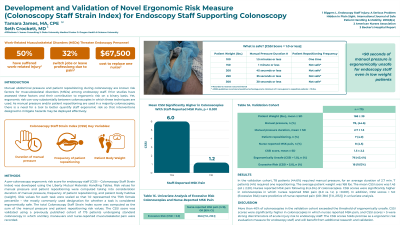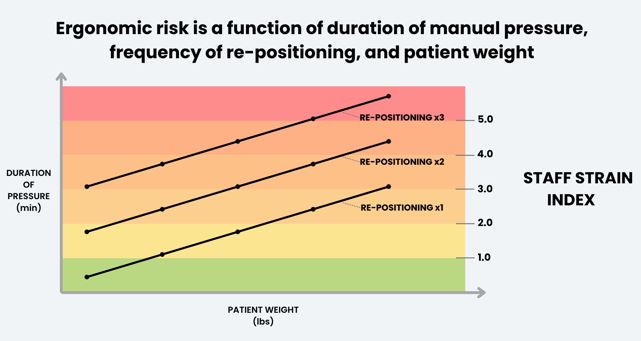Sunday Poster Session
Category: General Endoscopy
P0658 - Development and Validation of Novel Ergonomic Risk Measure (Colonoscopy Staff Strain Index) for Endoscopy Staff Supporting Colonoscopy
Sunday, October 27, 2024
3:30 PM - 7:00 PM ET
Location: Exhibit Hall E

Has Audio
- TJ
Tamara James, MA
James Consulting, Duke University Medical Center
Clarksville, VA
Presenting Author(s)
Tamara James, MA1, Seth Crockett, MD2
1James Consulting, Duke University Medical Center, Clarksville, VA; 2Oregon Health & Science University, Portland, OR
Introduction: Manual abdominal pressure and patient repositioning during colonoscopy are known risk factors for musculoskeletal disorders (MSDs) among endoscopy staff. Prior studies have assessed these factors and their contribution to ergonomic risk on a binary basis. Yet, ergonomic risk can vary substantially between colonoscopies in which these techniques are used. As manual pressure and/or patient repositioning are used in a majority colonoscopies, there is a need for a tool to better quantify staff ergonomic risk so that interventions designed to mitigate hazards may be deployed effectively.
Methods: A per-colonoscopy ergonomic risk score for endoscopy staff (CSSI – Colonoscopy Staff Strain Index) was developed using the Liberty Mutual Materials Handling Tables. Risk values for manual pressure and patient repositioning were computed taking into consideration duration of manual pressure, frequency of patient repositioning, and patient body habitus (weight). Risk values for each task were scaled so that 1.0 represented the 75th female percentile – the mostly commonly used designation for whether a task is considered ergonomically safe. The total Colonoscopy Staff Strain Index score was computed as the sum of the manual pressure and patient repositioning risk values. The CSSI score was validated using a previously published cohort of 175 patients undergoing standard colonoscopy in which ancillary maneuvers and nurse-reported musculoskeletal pain were recorded.
Results: In the validation cohort, 78 patients (44.6%) required manual pressure, for an average duration of 2.7 min. 7 patients (4%) required one repositioning. The average patient weight was 168 lbs. The mean CSSI score was 1.45 (sd ± 2.20). Nurses reported MSK pain following 8 (4.5%) of colonoscopies. CSSI scores were significantly higher in colonoscopies in which nurses reported MSK pain (6.0 vs. 1.2, p >0.001). In addition, CSSI scores > 5.0 (Excessive Risk) were predictive of nurse-reported pain (OR: 38.6 [7.0, 213.1]) in univariate analysis.
Discussion: More than 40% of colonoscopies in the validation cohort exceeded the threshold of ergonomically unsafe. CSSI scores were significantly higher in colonoscopies in which nurses reported MSK-pain, and CSSI scores > 5 were strong discriminators of acute injury risk to endoscopy staff. The CSSI scores holds promise as a ergonomic risk evaluation measure for endoscopy staff, and will benefit from additional research and validation.

Note: The table for this abstract can be viewed in the ePoster Gallery section of the ACG 2024 ePoster Site or in The American Journal of Gastroenterology's abstract supplement issue, both of which will be available starting October 27, 2024.
Disclosures:
Tamara James, MA1, Seth Crockett, MD2. P0658 - Development and Validation of Novel Ergonomic Risk Measure (Colonoscopy Staff Strain Index) for Endoscopy Staff Supporting Colonoscopy, ACG 2024 Annual Scientific Meeting Abstracts. Philadelphia, PA: American College of Gastroenterology.
1James Consulting, Duke University Medical Center, Clarksville, VA; 2Oregon Health & Science University, Portland, OR
Introduction: Manual abdominal pressure and patient repositioning during colonoscopy are known risk factors for musculoskeletal disorders (MSDs) among endoscopy staff. Prior studies have assessed these factors and their contribution to ergonomic risk on a binary basis. Yet, ergonomic risk can vary substantially between colonoscopies in which these techniques are used. As manual pressure and/or patient repositioning are used in a majority colonoscopies, there is a need for a tool to better quantify staff ergonomic risk so that interventions designed to mitigate hazards may be deployed effectively.
Methods: A per-colonoscopy ergonomic risk score for endoscopy staff (CSSI – Colonoscopy Staff Strain Index) was developed using the Liberty Mutual Materials Handling Tables. Risk values for manual pressure and patient repositioning were computed taking into consideration duration of manual pressure, frequency of patient repositioning, and patient body habitus (weight). Risk values for each task were scaled so that 1.0 represented the 75th female percentile – the mostly commonly used designation for whether a task is considered ergonomically safe. The total Colonoscopy Staff Strain Index score was computed as the sum of the manual pressure and patient repositioning risk values. The CSSI score was validated using a previously published cohort of 175 patients undergoing standard colonoscopy in which ancillary maneuvers and nurse-reported musculoskeletal pain were recorded.
Results: In the validation cohort, 78 patients (44.6%) required manual pressure, for an average duration of 2.7 min. 7 patients (4%) required one repositioning. The average patient weight was 168 lbs. The mean CSSI score was 1.45 (sd ± 2.20). Nurses reported MSK pain following 8 (4.5%) of colonoscopies. CSSI scores were significantly higher in colonoscopies in which nurses reported MSK pain (6.0 vs. 1.2, p >0.001). In addition, CSSI scores > 5.0 (Excessive Risk) were predictive of nurse-reported pain (OR: 38.6 [7.0, 213.1]) in univariate analysis.
Discussion: More than 40% of colonoscopies in the validation cohort exceeded the threshold of ergonomically unsafe. CSSI scores were significantly higher in colonoscopies in which nurses reported MSK-pain, and CSSI scores > 5 were strong discriminators of acute injury risk to endoscopy staff. The CSSI scores holds promise as a ergonomic risk evaluation measure for endoscopy staff, and will benefit from additional research and validation.

Figure: Colonoscopy Staff Strain Index
Note: The table for this abstract can be viewed in the ePoster Gallery section of the ACG 2024 ePoster Site or in The American Journal of Gastroenterology's abstract supplement issue, both of which will be available starting October 27, 2024.
Disclosures:
Tamara James: ColoWrap, LLC – Consultant.
Seth Crockett indicated no relevant financial relationships.
Tamara James, MA1, Seth Crockett, MD2. P0658 - Development and Validation of Novel Ergonomic Risk Measure (Colonoscopy Staff Strain Index) for Endoscopy Staff Supporting Colonoscopy, ACG 2024 Annual Scientific Meeting Abstracts. Philadelphia, PA: American College of Gastroenterology.
